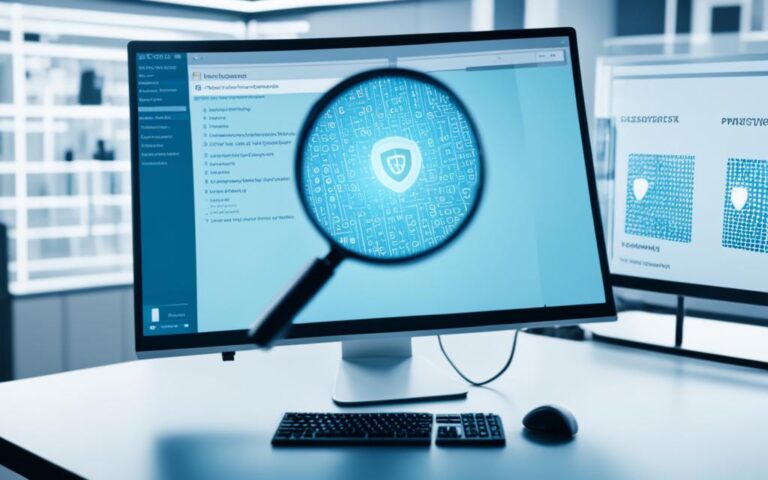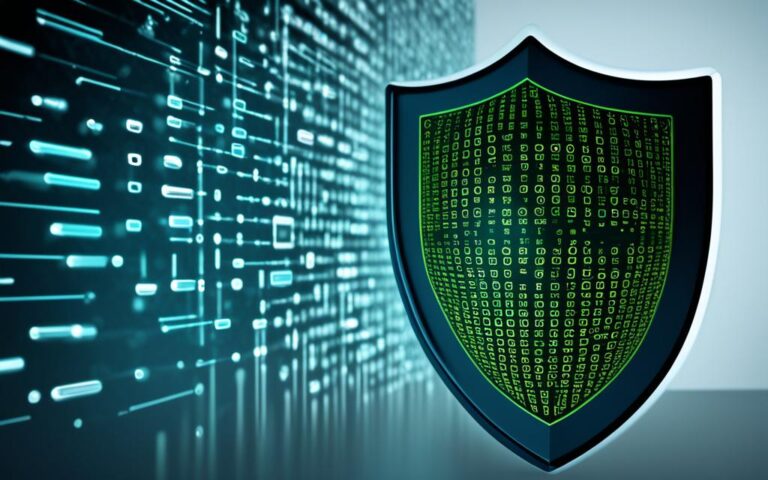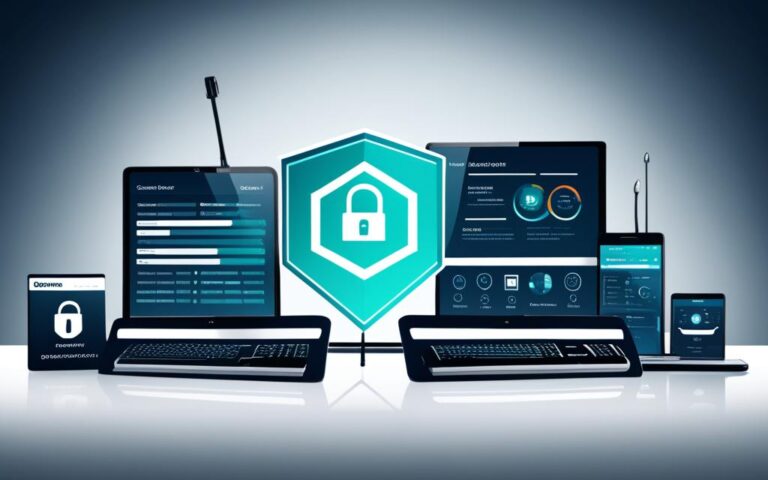Threat Neutralization: Advanced Strategies for IT Professionals
Welcome to our comprehensive guide on threat detection and response strategies for IT professionals. In today’s digital landscape, cyber defences play a crucial role in safeguarding organizations and their sensitive data from ever-evolving threats. With a proactive approach to threat detection and response, IT professionals can minimize potential damage and protect valuable assets.
In this article, we will explore the key principles and best practices for effective threat detection and response. From understanding the basics of threat detection to implementing advanced strategies, we will provide actionable insights to enhance your cyber security measures.
Throughout the article, we will emphasize the importance of protecting sensitive data and the role of IT professionals in maintaining a secure environment. By staying ahead of potential threats and swiftly neutralizing them, you can ensure the integrity and confidentiality of critical information.
So, make sure to read on as we delve into the world of threat detection and response, equipping you with the knowledge and tools to fortify your cyber defenses.
What Is Threat Detection and Response?
Threat detection and response is the process of identifying potential threats and taking swift action to neutralize them. It involves collecting data from various sources, such as network traffic and system logs, and analyzing it for anomalies or suspicious behavior. This ensures that cyber attacks are detected and mitigated in a timely manner.
With the increasing frequency and sophistication of cyber attacks, organizations need robust threat detection and response mechanisms in place to protect their data and minimize the impact of breaches. By implementing effective threat detection and response strategies, companies can reduce the risk of data loss, mitigate financial and reputational damage, and avoid costly recovery expenses.
Threat detection and response encompasses several key steps:
- Data Collection: Data from various sources, including network traffic and system logs, is collected for analysis.
- Anomaly Detection: Advanced threat intelligence and machine learning algorithms analyze the collected data to identify unusual or suspicious activity that may indicate a cyber attack.
- Threat Identification: Once potential threats are detected, further analysis is conducted to determine the nature and scope of the attack.
- Response and Mitigation: A response plan is executed to neutralize the threat and mitigate its impact. This may involve isolating affected systems, blocking malicious traffic, and removing malicious code or software.
Effective threat detection and response measures are essential to protect sensitive data and safeguard business operations. In today’s constantly evolving cyber threat landscape, organizations must proactively monitor and respond to potential threats to minimize the risk of data breaches and other cybersecurity incidents.
“Cyber attacks are constantly evolving, and organizations need advanced threat detection and response capabilities to stay one step ahead of potential threats.” – Cybersecurity Expert
The Importance of Threat Detection and Response
Threat detection and response is crucial due to the following reasons:
- Minimizing Data Loss: Swift and effective threat detection and response mitigates the risk of data loss, protecting sensitive information from falling into the wrong hands.
- Reducing Recovery Costs: By identifying and neutralizing threats early on, organizations can minimize the financial impact of cyber attacks and avoid costly recovery expenses.
- Preventing Business Disruption: Timely detection and response help prevent business disruptions caused by cyber attacks, ensuring continuous operations and maintaining customer trust.
- Identifying Suspicious Activity: Through continuous monitoring and analysis, organizations can identify suspicious activities that may indicate potential threats before they escalate.
- Addressing Potential Threats: Threat detection and response provides an opportunity to identify weaknesses in security measures and take proactive steps to address potential vulnerabilities.
Implementing a comprehensive threat detection and response strategy is essential for organizations across all industries. It enables proactive cybersecurity practices and helps organizations stay ahead of evolving threats.
Best Practices for Threat Detection
One of the best practices for enhancing threat detection capabilities is by utilizing advanced threat intelligence tools. These tools monitor and analyze threat data from various sources, providing IT professionals with valuable insights into emerging threats and attack patterns. By staying informed about the latest threats, organizations can proactively implement necessary measures to mitigate risks.
Another crucial step in threat detection is performing regular vulnerability assessments. These assessments help identify weaknesses in systems and applications before they are exploited by cybercriminals. By conducting in-depth vulnerability scans and penetration testing, IT professionals can uncover potential security gaps and take appropriate actions to address them.
Establishing baseline behavior profiles is also essential for effective threat detection. By monitoring the normal behavior of systems and users, IT professionals can quickly identify any deviations or anomalies that may indicate a potential security breach. This allows for timely detection and response to mitigate the impact of an attack.
Leveraging artificial intelligence and machine learning technologies can significantly enhance threat detection capabilities. These technologies enable the automatic analysis of large datasets, identifying patterns and anomalies that may indicate malicious activity. By continuously learning from new data, AI and machine learning algorithms can adapt and evolve, staying one step ahead of cyber threats.
Using advanced threat intelligence tools, regularly conducting vulnerability assessments, establishing baseline behavior profiles, and leveraging artificial intelligence and machine learning are key best practices for effective threat detection.
To summarize, a comprehensive approach to threat detection includes incorporating advanced threat intelligence, performing regular vulnerability assessments, establishing baseline behavior profiles, and utilizing artificial intelligence and machine learning technologies. By implementing these best practices, IT professionals can strengthen their organization’s defenses against evolving cyber threats.
Best Practices for Threat Response
When it comes to effectively responding to cyber attacks, IT professionals need to follow best practices to minimize damage and protect sensitive data. This section outlines key strategies and measures that can be implemented.
1. Incident Response Plans
Creating and regularly testing incident response plans is crucial for a swift and coordinated response to cyber attacks. These plans outline the steps to be taken when an incident occurs, ensuring that all relevant personnel are aware of their roles and responsibilities. By having a well-defined plan in place, organizations can minimize the impact of attacks and mitigate potential damage.
2. Communication Protocols
Establishing clear communication protocols is essential to ensure a timely and effective response. When an incident occurs, it is crucial to have open and efficient lines of communication to share information and coordinate actions. This includes defining communication channels, escalation procedures, and contact lists. By enabling effective communication, organizations can respond swiftly and mitigate the impact of attacks.
3. Threat Isolation and Containment
In the event of a cyber attack, it’s vital to quickly identify affected systems and isolate them from the rest of the network. This involves disconnecting compromised systems from the internet and quarantining affected areas to prevent the spread of the attack. By containing the threat and limiting its reach, organizations can minimize damage and protect critical assets.
4. Remediation
Once the immediate threat has been contained, organizations need to address the root cause of the attack and implement remediation measures. This includes removing any malicious code or software, patching vulnerabilities, and strengthening security controls. By addressing the underlying issues, organizations can prevent future incidents and enhance their overall security posture.
5. Employee Training
An essential aspect of effective threat response is training employees on response procedures. Ensuring that all staff members are aware of their roles and responsibilities during a cyber attack is crucial for a coordinated and effective response. Regular training sessions and simulated exercises can help educate employees about potential threats, teach them how to identify and report suspicious activity, and familiarize them with incident response plans.
Benefits of a Threat Detection Strategy
Implementing a comprehensive threat detection and response strategy can provide numerous benefits for organizations. By minimizing damage and protecting sensitive data, such as credit card numbers and personally identifiable information, organizations can maintain trust with their customers. Additionally, meeting compliance requirements is essential to ensure that organizations adhere to relevant regulations and standards.
A robust threat detection strategy not only helps organizations comply with regulations but also strengthens their defenses against evolving threats. By continually monitoring networks and applications for suspicious activity, organizations can identify and neutralize threats early on. This proactive approach significantly reduces the potential damage caused by cyber attacks, including system downtime and data loss.
“A robust threat detection strategy can minimize the damage caused by cyber attacks, including system downtime and data loss.”
Furthermore, implementing a comprehensive threat detection and response strategy enables organizations to recover faster from attacks. When an attack occurs, organizations with robust strategies can quickly isolate affected systems, block malicious traffic, and remove malicious code or software. This swift response minimizes the impact of the attack and allows organizations to resume normal operations more efficiently.
Overall, a comprehensive threat detection and response strategy:
- Minimizes damage caused by cyber attacks
- Protects sensitive data, maintaining customer trust
- Ensures compliance with regulations
- Strengthens defenses against evolving threats
- Enables faster recovery from attacks
Benefits of a Threat Detection Strategy
| Benefit | Description |
|---|---|
| Minimizing Damage | A comprehensive threat detection strategy helps minimize the damage caused by cyber attacks, including system downtime and data loss. |
| Protecting Sensitive Data | By detecting and responding to threats, organizations can protect sensitive data, such as credit card numbers and personally identifiable information, ensuring the trust of their customers. |
| Meeting Compliance Requirements | A robust threat detection strategy supports organizations in meeting compliance requirements and adhering to relevant regulations and standards. |
| Stronger Defenses | Implementing a comprehensive threat detection and response strategy strengthens an organization’s defenses against evolving threats. |
| Faster Recovery | When an attack occurs, organizations with a robust strategy can recover faster by isolating affected systems, blocking malicious traffic, and removing malicious code or software. |
By considering and implementing a comprehensive threat detection and response strategy, organizations can minimize the damage caused by cyber attacks, protect sensitive data, meet compliance requirements, strengthen their defenses, and enable faster recovery from attacks.
The Diamond Model and the Cyber Kill Chain: Models for Understanding and Countering Threats
The Diamond Model and the Cyber Kill Chain are two commonly used models for understanding and countering cyber threats. These models provide valuable insights into the threat landscape, attack vectors, and the process of threat analysis.
The Diamond Model
The Diamond Model is a framework that helps analysts analyze and decompose cyber threats into four primary vertices:
- Adversary: Focuses on understanding the motivations, capabilities, and objectives of the attackers.
- Infrastructure: Examines the tools, techniques, and infrastructure used by the attackers.
- Victim: Considers the target organization or individual and their vulnerabilities.
- Capability: Refers to the defender’s ability to prevent, detect, and respond to threats.
By studying these vertices, analysts can piece together an attacker’s tactics and refine defensive measures to counter them effectively.
The Cyber Kill Chain
The Cyber Kill Chain is a sequential breakdown of an attack’s lifecycle. It helps defenders recognize, interject, and neutralize threats at different stages. The stages of the Cyber Kill Chain include:
- Reconnaissance: Gathering information about the target.
- Weaponization: Creating and preparing the attack tools.
- Delivery: Transmitting the attack to the target.
- Exploitation: Taking advantage of vulnerabilities to gain access.
- Installation: Setting up persistent access within the target’s systems.
- Command and Control: Establishing communication and control over the compromised systems.
- Actions on Objectives: Performing malicious activities, such as data exfiltration or system disruption.
By understanding the different stages of the Cyber Kill Chain, defenders can develop strategies to intervene and disrupt the attack at various points, mitigating potential damage.
Cyber Threat Landscaping: Mapping the Digital Terrain
Cyber Threat Landscaping is a crucial step in cybersecurity, aimed at identifying the most significant targets within an organization. By prioritizing assets based on their criticality and potential attractiveness to adversaries, IT professionals can allocate resources effectively and fortify their defenses. This process involves in-depth analysis and strategic decision-making.
One essential aspect of Cyber Threat Landscaping is user behavior analysis. By examining user activity and detecting anomalies, IT professionals can spot potential threats targeting high-profile individuals. This proactive approach allows for early detection and swift response, minimizing the impact of such threats.
Another vital component of Cyber Threat Landscaping is attack surface analysis. It involves mapping the potential vectors of attack that adversaries may exploit. By thoroughly analyzing the organization’s attack surface, weaknesses can be identified and addressed promptly. This proactive approach enables IT professionals to strengthen their defenses and stay one step ahead of potential threats.
Staying updated on emerging threats is also crucial in Cyber Threat Landscaping. IT professionals need to be aware of the constantly evolving threat landscape and emerging attack techniques. Analyzing emerging threats allows for the formulation of effective countermeasures and proactive defense measures.
Benefits of Cyber Threat Landscaping
Cyber Threat Landscaping offers several key benefits to IT professionals:
- Efficient asset prioritization based on criticality
- Proactive identification of high-profile targets
- Effective defense measures by addressing attack surface vulnerabilities
- Stay ahead of emerging threats
By leveraging asset prioritization, user behavior analysis, attack surface analysis, and emerging threat analysis, IT professionals can map the digital terrain and create a robust defense strategy to counter cyber threats effectively.
With the ever-increasing sophistication of cyber threats, organizations must adopt a proactive approach to cybersecurity. Cyber Threat Landscaping provides a comprehensive understanding of the digital terrain, enabling IT professionals to implement the necessary measures to protect sensitive data and maintain a secure environment.
Conclusion
Cyber Threat Intelligence is an essential component of cybersecurity for IT professionals, providing valuable insights for strategic decision-making. By leveraging the power of threat intelligence, organizations gain a comprehensive understanding of the ever-evolving threat landscape. This vantage point enables them to proactively identify and prioritize risks, allowing for more informed and effective strategic decisions.
In addition to strategic decision-making, Cyber Threat Intelligence also offers tactical awareness. By delving into specific threats, IT professionals can access detailed insights into adversary tactics and techniques. Armed with this knowledge, defenders can swiftly respond to emerging threats, deploying targeted countermeasures and mitigating potential risks before they materialize into full-scale attacks.
The integration of real-time threat data into security tools and solutions brings operational advantages. By transforming static defenses into dynamic and adaptive systems, organizations can stay one step ahead of cybercriminals. With real-time intelligence, IT professionals can proactively identify and neutralize threats, enhancing overall cyber defenses while minimizing the impact of cyber attacks.
To strengthen their cybersecurity posture, organizations must adopt a comprehensive threat detection and response strategy supported by Cyber Threat Intelligence. By combining strategic decision-making, tactical awareness, and operational advantages, IT professionals can effectively safeguard sensitive data and critical systems. Embracing cyber threat intelligence as a core component empowers organizations to successfully navigate the ever-changing cyber landscape and stay ahead of emerging threats.












